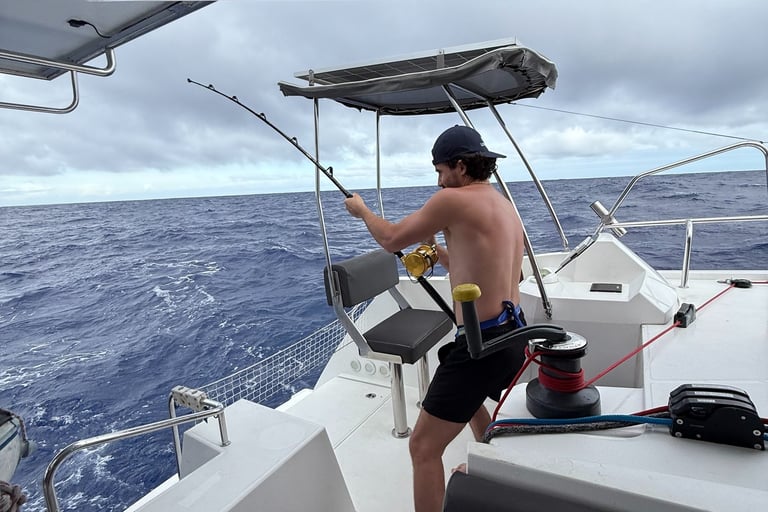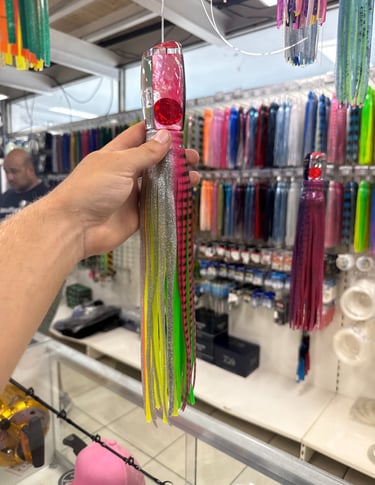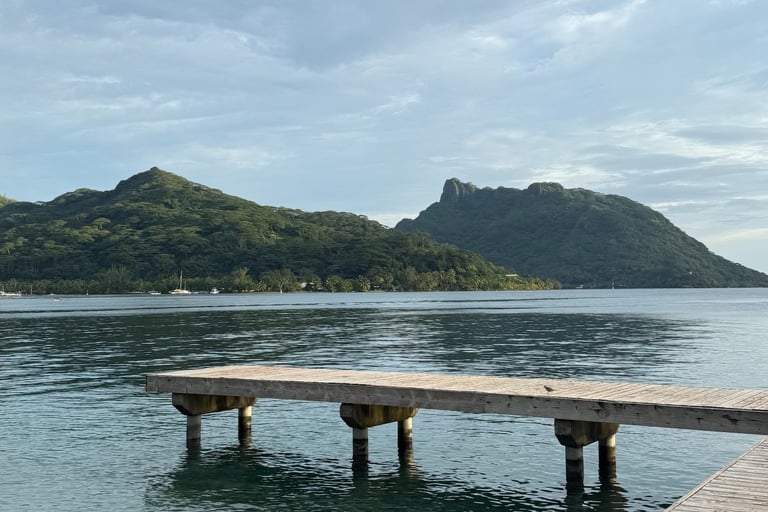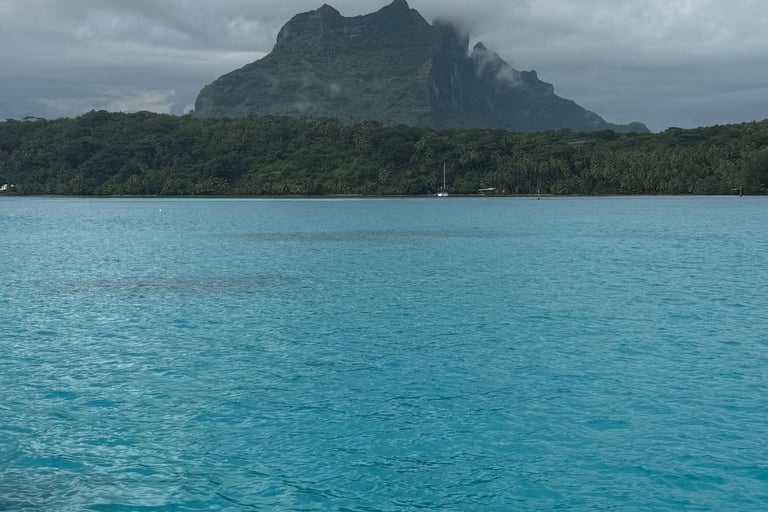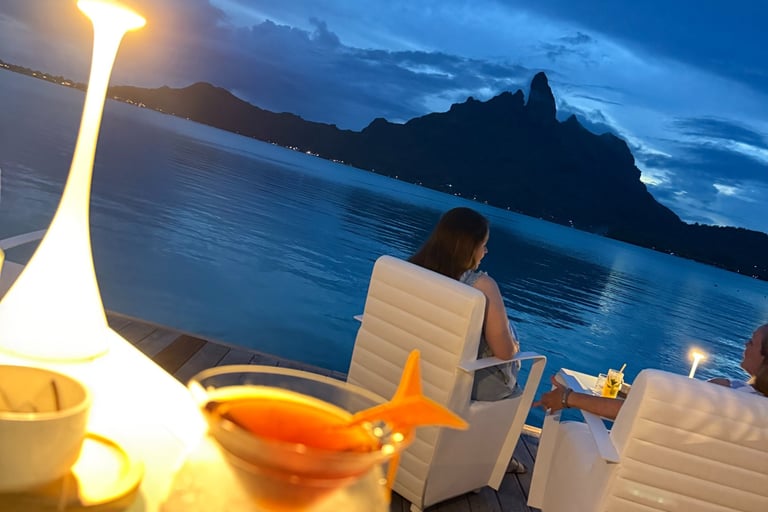Sailing On, The Society Islands
Downwind sailing, gear failures, new crew, and a peaceful goodbye to French Polynesia, this leg reminded us why boat life is worth every challenge.
5/3/20256 min read


Bernie and I began our long sail back to Tahiti and we were actually excited about it. For the first time since we started this trip, the conditions were finally lining up for some proper downwind sailing. We had been looking forward to seeing how Telemachus would perform, especially with the Code 0 we had not yet used.
Hoisting it for the first time was its own adventure. We fumbled around a bit trying to figure out the setup but when we finally got it flying, we were blown away. The sail is massive and just effortlessly carried us through the swell. It quickly became my favorite sail onboard. The way it pulled us forward while the sun was out and the boat glided with ease was exactly the kind of sailing I had dreamed of.
Most of the sail was peaceful and smooth. Toward the end of the passage, Bernie and I were talking about how, besides the marlin we lost, we had only really caught bonitos so far. Almost like the ocean was listening, the reel started screaming. FISH ON!
We kicked into gear, furling the gennaker and putting the engines in idle. When I grabbed the rod I knew immediately this wasn’t a bonito. The line was flying out and the pressure on it felt massive. Bernie and I fell into a rhythm, taking turns, working together without saying much. For two hours we played a game of red light green light with this fish, slowly getting it closer and closer. At 20 meters away we finally started to see color, and then, just like that, the line went slack. The hook had come loose. It was quiet after that, the kind of quiet that only comes after a long fight and a clean loss.
When we arrived in Tahiti we were met by two new additions to our crew, Mia and Dorina, two German travelers who were passionate about exploring the South Pacific and helping out on boats. That week became full-on prep mode for the next leg of the journey. We knew it would be a while before we had access to proper supplies again, probably not until Fiji, so we stocked up.
We visited the doctor, made multiple trips to the marine store, and picked up a few more lures and a new, stronger rod. Bernie and I both agreed we would get the last laugh next time that reel started screaming.
With the boat fully loaded and the crew ready, we set out for the Society Islands. First stop was Huahine, with hopes to see Taha, Maupiti, and Bora Bora after. We were in a bit of a rush leaving Tahiti, eager to get back out and see new islands.
The sail to Huahine started off rough. Within the first couple hours we got hit with 30 plus knots of wind and our traveler car snapped off the mainsheet. Another thing for the fix-it list. But the rest of the sail smoothed out and when we finally dropped anchor, we were rewarded with one of the most beautiful anchorages I have seen.
Towering mountains spilled into the sea behind us and the water was a glowing turquoise ten feet deep. The anchorage was crowded with about twenty boats and we nearly gave up after trying to anchor six or seven times. But we eventually found a small opening and dropped the hook.
That night we met a fellow Spanish sailor named Nito. He had sailed all the way from Spain and ended up falling in love with French Polynesia, especially Huahine, where he has lived for six years now. Over a few beers we traded stories and paella recipes, and he offered to help us find good spearfishing spots. He even gifted us his old paellera so we could keep the tradition going as we head west.
We dinghied back to Telemachus just in time for dinner, but as soon as we sat down we noticed a boat drifting a little too close. It took us a second to realize two things. First, it was Nito’s boat, and second, it wasn’t him moving, it was us. Our anchor was dragging.
We jumped up, turned on the engines, and began dodging the surrounding boats. It was dark, the anchorage was tight, and things felt tense. Just when it looked like we were going to have to anchor in an impossible spot, a man in a dinghy approached.
His name was Juan, from El Barco Amarillo, and he offered to help us out. He climbed aboard and guided us around, but even he admitted the anchorage was packed beyond capacity. We ended up anchoring in a deeper channel knowing we’d have to move early the next morning.
Once settled, we invited Juan for a drink and he taught us about the unique seabed in Huahine. The sand is just a thin layer over hard bottom, which explains why our anchor hadn’t held. He drew diagrams, showed us techniques he uses specific to this kind of bottom, none of it by the book but all of it based on experience.
One thing he said stuck with me. He told us that many sailors let ego get in the way, and they hesitate to ask for help when things go wrong. He said he appreciated how quick we were to accept his help, and it surprised me to hear that was rare.
I think a lot of people assume they have to prove something out here, but the ocean doesn’t care. There’s no room for ego on a boat. No matter how much you know, there’s always something new to learn and someone who’s been through it before. I’ll keep doing my best to stay humble, keep learning, and take advice where I can get it.
The following days in Huahine were much more relaxed. We visited artisan shops, snorkeled, efoiled, spearfished, and finally I started to get the hang of efoiling. The island had a calm, easy rhythm and we fell right into it.
But time was tight. We had to be in the Cook Islands by May 6 and needed to make a quick stop in Bora Bora for diesel. On the way there, things got interesting.
About five miles from port our starboard engine fluttered and died. At first we thought we were out of fuel. The sensor had been off and it turned out we had run the tank low because we filled it 50 liters short. Thankfully we had just enough left to limp into port. The problem was, now we were arriving at night with only one motor and needed to maneuver onto a mooring ball.
Bora Bora is well marked and has wide channels so we were lucky, but had that happened at one of the smaller islands it would have been a much bigger problem.
Once we were moored up we looked around and were pleasantly surprised. We had heard mixed reviews about Bora Bora being too touristy but the side we ended up on was quiet. Only one other boat shared the anchorage with us. The water was pristine, the town was small, with a couple grocery stores and restaurants. It felt like a perfect stop.
Downwind sailing, gear failures, new crew, and a peaceful goodbye to French Polynesia, this leg reminded us why boat life is worth every challenge.
We spent a few days there paddleboarding, windsurfing, efoiling, and eating out. On our last night Bernie and I decided to splurge and went to the St. Regis for dinner. It had been a while since we had a proper fine dining experience and from the moment they brought out warm marcona almonds with our drinks I was hit with a wave of perspective.
Downwind sailing, gear failures, new crew, and a peaceful goodbye to French Polynesia — this leg reminded us why boat life is worth every challenge.
Something so small, something I wouldn’t have even noticed in Miami, suddenly felt incredible. Each almond felt like a little piece of home and comfort. The rest of the meal followed suit.
We enjoyed it fully but as we left, Bernie and I both knew we wouldn’t miss it. The experiences we’re living on the water are richer in their own way. Still, it was a nice reminder of how far we’ve come.
The next morning we refueled, did our final checks, and set sail for the Cook Islands.
As I write this it is just past 1am. I am on the first night shift, alone in the cockpit, more than 200 miles from land in every direction. The sea is calm and the stars above are clearer than I’ve ever seen them.
The Milky Way is bright and colorful, stretched across the sky like a painting. Normally you don’t pay too much attention to the stars but when you’re out here, away from everything, it’s hard not to.
And I think to myself, this is a fair trade for warm marcona almonds.
